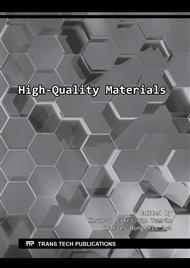[1]
D.E. Rusyniak, A. Arroyo, J. Acciani, B, Froberg, L, Kao, B. Furbee, Molecular, clinical and environmental toxicology, Nat Ins of Health J. 100 (2009) 365-396.
DOI: 10.1007/978-3-7643-8338-1_11
Google Scholar
[2]
R.A. Wuana, F.E. Okieimen, Heavy metals in contaminated soils: a review of sources, chemistry, risks and best available strategies for remediation, Isrn Ecology. (2011) 1-20.
DOI: 10.5402/2011/402647
Google Scholar
[3]
E. Bazrafshan, L. Mohammadi, A. Ansari-Moghaddam, A.H. Mahvi, Heavy metals removal from aqueous environments by electrocoagulation process–a systematic review, J Environ Health Sci Eng. 13 (2015) 74.
DOI: 10.1186/s40201-015-0233-8
Google Scholar
[4]
S.M. Yakout, A.E. Daifullah, S.A. El-Reefy, Pore structure characterization of chemically modified biochar derived from rice straw, Environ Eng Manag J (EEMJ). 14(2015).
DOI: 10.30638/eemj.2015.049
Google Scholar
[5]
T.S. Malarvizhi, T. Santhi, Lignite fired fly ash modified by chemical treatment for adsorption of zinc from aqueous solution, Res Chem Intermed. 39 (2013) 2473-2494.
DOI: 10.1007/s11164-012-0774-8
Google Scholar
[6]
N.A. Fathy, O.I. El-Shafey, L.B. Khalil, Effectiveness of alkali-acid treatment in enhancement the adsorption capacity for rice straw: the removal of methylene blue dye, ISRN Phys Chem (2013).
DOI: 10.1155/2013/208087
Google Scholar
[7]
M.B. Ahmed, J.L. Zhou, H.H. Ngo, W. Guo, M. Chen, Progress in the preparation and application of modified biochar for improved contaminant removal from water and wastewater, Bioresour. Technol. 214 (2016) 836-51.
DOI: 10.1016/j.biortech.2016.05.057
Google Scholar
[8]
A. Tripathi, M.R. Ranjan, Heavy metal removal from wastewater using low cost adsorbents, J Bioremed Biodeg 6 (2015) 315.
DOI: 10.4172/2155-6199.1000315
Google Scholar
[9]
M. Basu, M. Pande, P.B. Bhadoria, S.C. Mahapatra, Potential fly-ash utilization in agriculture: a global review, Prog Nat Sci. 19 (2009)1173-1186.
DOI: 10.1016/j.pnsc.2008.12.006
Google Scholar
[10]
M. Ghaedi, N. Mosallanejad, Removal of heavy metal ions from polluted waters by using of low-cost adsorbents.
Google Scholar
[11]
R. Wahi, Z. Ngaini, V.U. Jok, Removal of mercury, lead and copper from aqueous solution by activated carbon of palm oil empty fruit bunch, World Appl Sci J. 5 (2009) 84-91.
Google Scholar
[12]
L.E. Hernandez-Mena, A.A. Pécoraa, A.L. Beraldob, Slow pyrolysis of bamboo biomass: analysis of biochar properties. Chem Eng 37 (2014).
Google Scholar
[13]
Y. Ma, W.J. Liu, N. Zhang, Y.S. Li, H. Jiang, G.P. Sheng, Polyethylenimine modified biochar adsorbent for hexavalent chromium removal from the aqueous solution, Bioresour Technol. 169 (2014) 403-408.
DOI: 10.1016/j.biortech.2014.07.014
Google Scholar
[14]
K.A. Komnitsas, D. Zaharaki, Morphology of modified biochar and its potential for phenol removal from aqueous solutions, Front Environ. Sci 4 (2016) 26.
DOI: 10.3389/fenvs.2016.00026
Google Scholar
[15]
K.J. Silgado, G.D. Marrugo, J. Puello, Adsorption of chromium (VI) by activated carbon produced from oil palm endocarp, Chem Eng 37 (2014).
Google Scholar
[16]
J.O. Amode, J.H. Santos, Z.M. Alam, A.H. Mirza, C.C. Mei, Adsorption of methylene blue from aqueous solution using untreated and treated (Metroxylon spp.) waste adsorbent: equilibrium and kinetics studies, Int J Ind Chem. 7 (2016) 333-345.
DOI: 10.1007/s40090-016-0085-9
Google Scholar
[17]
M. Visa, M. Nacu, R.A. Carcel, Fly ash substrates for complex wastewater treatment. InWorld of Coal Ash (WOCA) Conference-May 2011 May 9 (pp.9-12).
Google Scholar
[18]
K. Al-Zboon, M.S. Al-Harahsheh, F.B. Hani, Fly ash-based geopolymer for Pb removal from aqueous solution, J. Hazard. Mater. 188 (2011) 414-21.
DOI: 10.1016/j.jhazmat.2011.01.133
Google Scholar
[19]
J.N. Edokpayi, J.O. Odiyo, E.O. Popoola, O.S. Alayande, T.A. Msagati, Synthesis and characterization of biopolymeric chitosan derived from land snail shells and its potential for Pb2+ removal from aqueous solution, Materials. 8 (2015) 8630-8640.
DOI: 10.3390/ma8125482
Google Scholar
[20]
S.B. Abdul Hamid, Z.Z. Chowdhury, S.M. Zain, Base catalytic approach: a promising technique for the activation of biochar for equilibrium sorption studies of copper, Cu (II) ions in single solute system, Materials. 7 (2014) 2815-2832.
DOI: 10.3390/ma7042815
Google Scholar
[21]
A.R. Usman, A.S. Sallam, A. Al-Omran, A.H. El-Naggar, K.K. Alenazi, M. Nadeem, M.I. Al-Wabel, Chemically modified biochar produced from conocarpus wastes: an efficient sorbent for Fe (II) removal from acidic aqueous solutions, Adsorp Sci Technol 31 (2013) 625-640.
DOI: 10.1260/0263-6174.31.7.625
Google Scholar
[22]
J.J. Clara, P.K. Sugirtha, Study of SEM/EDXS and FTIR for fly ash to determine the chemical changes of ash in marine environment, Int. J. Sci. Res. 5 (2016)1688-93.
Google Scholar
[23]
M.M. Rao, D.K. Reddy, P. Venkateswarlu, K. Seshaiah, Removal of mercury from aqueous solutions using activated carbon prepared from agricultural by-product/waste, J Environ Manage 90 (2009) 634-643.
DOI: 10.1016/j.jenvman.2007.12.019
Google Scholar
[24]
J. Luo, H. Shen, H. Markström, Z. Wang, Q. Niu. Removal of Cu2+ from aqueous solution using fly ash. JMMCE 10 (2011) 561-571.
DOI: 10.4236/jmmce.2011.106043
Google Scholar
[25]
A.K. Agarwal, M.S. Kadu, C.P. Pandhurnekar, I.L. Muthreja, Kinetics and adsorption isotherm study of removal of Zn+ 2 ions from aqueous solution using thermal power plant fly ash. IJESD 3 (2012) 376.
DOI: 10.7763/ijesd.2012.v3.251
Google Scholar
[26]
M. Inyang, B. Gao, W. Ding, P. Pullammanappallil, A.R. Zimmerman, X. Cao, Enhanced lead sorption by biochar derived from anaerobically digested sugarcane bagasse, Sep Sci Technol 46 (2011) 1950-1956.
DOI: 10.1080/01496395.2011.584604
Google Scholar
[27]
S. Prapagdee, S. Piyatiratitivorakul, A. Petsom, Activation of Cassava Stem Biochar by Physico-Chemical Method for Stimulating Cadmium Removal Efficiency from Aqueous Solution, EnvironmentAsia 7 (2014) 60-69.
DOI: 10.3233/ajw-160004
Google Scholar
[28]
A.O. Dada, A.P. Olalekan, A.M. Olatunya, O.J. Dada, Langmuir, Freundlich, Temkin and Dubinin–Radushkevich isotherms studies of equilibrium sorption of Zn2+ unto phosphoric acid modified rice husk, 3 (2012) 38-45.
DOI: 10.9790/5736-0313845
Google Scholar
[29]
S. Chowdhury, F. Yusof, M.O. Faruck, N. Sulaiman, Process optimization of silver nanoparticle synthesis using response surface methodology, Procedia engineering (2016) 992-999.
DOI: 10.1016/j.proeng.2016.06.552
Google Scholar


